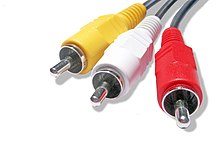Composite video
Composite Video [ ˈkɑːmpəzɪt ˈvɪdioʊ , also kəmˈpɑːzət ] is the internationally used English term for theanalog method for the transmission of an image channel, which is called“ FBAS ”in German-speaking countries (or “ BAS ” if there is no color information), comparable to a single television channel, but without audio or sound.
With composite , the entire image information is transmitted via one line, which leads to a comparatively poor image quality. S-video with two channels or component video with three or more channels are better .
The image format used in composite video can be PAL , SECAM or NTSC , so due to the history of its origins it is always an analog television signal in normal resolution ( SD ), i.e. never an HDTV signal.
connections

In 1978, from France , SCART was introduced in Europe and markets influenced by Europe. FBAS is transmitted directly via SCART , often together with RGB or later also S-Video ; the target device can then select the signal it can handle based on its capabilities. The SCART connection is only common in Europe.
In the environment of production companies, radio and television companies, BNC connections with 75 Ω impedance for FBAS are predominantly used today . The reasons for this are the higher quality mechanical design, better EMC shielding and the locking mechanism of BNC compared to Cinch as well as the general system disadvantages of Cinch.

In the USA, FBAS has been typically transmitted via a yellow cinch plug for a long time , usually combined with a white (or black) and a red cinch plug for left and right stereo audio signals. Since the 1980s and 1990s, cinch has also been used in Europe for many peripheral devices to be connected to the television (camcorders, game consoles, inputs and outputs of TV cards , inputs on video recorders).
Comparison with RF modulation
A number of devices that can be connected to the television, for example many game consoles and almost all video recorders, initially output a composite signal with a level of 1 V pp . If the television does not offer a suitable input, but only a classic antenna socket, this signal must be converted together with the audio signal by means of an RF modulator . The RF modulator is often left outside the device on consoles. Video recorders and similar devices already have to convert RF signals into their tuners, which is why the modulators are almost always available internally. Most home computers of the 1980s also contained an internal modulator, because back then only a few televisions offered SCART or video sockets and therefore almost all users needed a modulator.
For picture and above all sound quality, it is better to avoid the detour via the HF . Most current video and television sets have suitable connectors.
The transmission of FBAS means that image and color signals are combined in terms of frequency. It is best to transmit them separately , either as a YUV or as an RGB signal . YUV is also defined for analog HDTV signals. The use of an S-Video connection is in between qualitatively.
